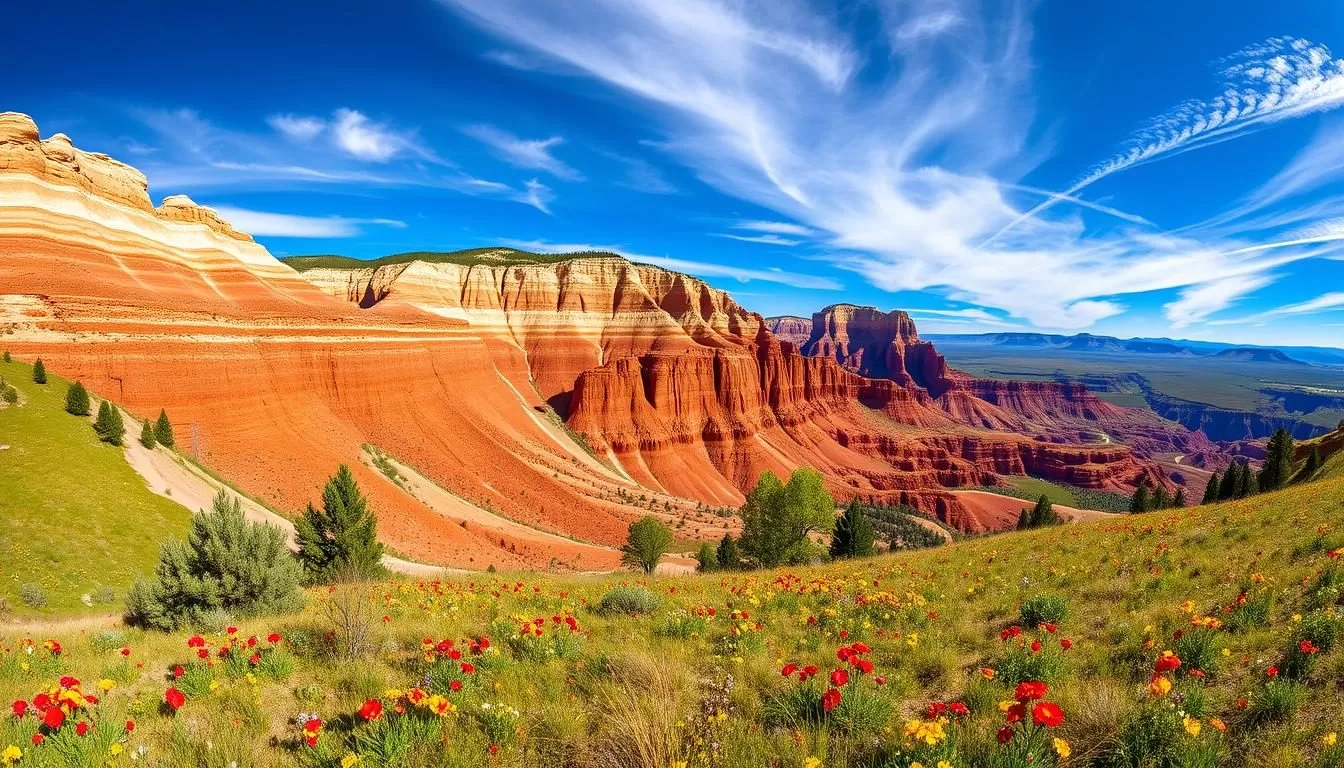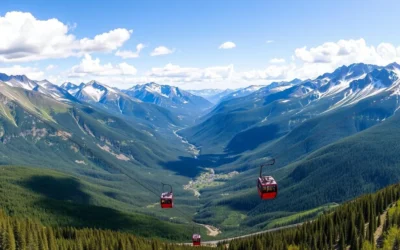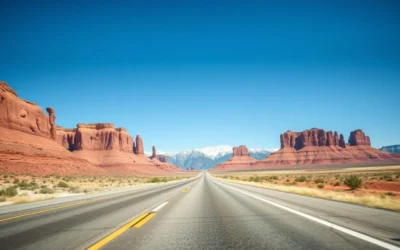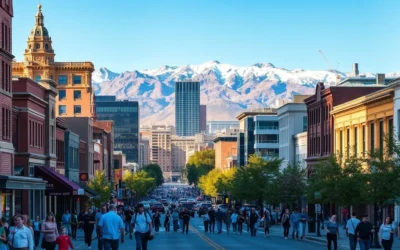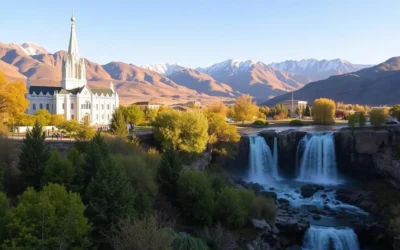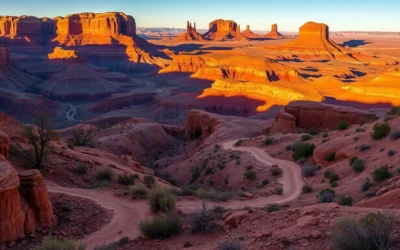Discover the natural wonder of a massive amphitheater, carved by millions of years of uplift and erosion, now known as Cedar Breaks National Monument. This hidden gem in southern Utah offers breathtaking scenery and diverse recreational activities.
You’ll be captivated by the colorful rock formations, ancient bristlecone pines, and spectacular alpine meadows. At an elevation of over 10,000 feet, this monument provides a cooler alternative to other Utah parks during the summer months.
Whether you’re a photographer, hiker, stargazer, or nature enthusiast, Cedar Breaks offers unforgettable experiences. Get ready to explore scenic viewpoints, hiking trails, and seasonal activities that will make your Utah adventure truly special.
Discover the Natural Wonder of Cedar Breaks

Cedar Breaks National Monument is a breathtaking natural wonder that will leave you speechless. The monument boasts a spectacular amphitheater, a natural coliseum over 2,000 feet deep and three miles across.
The Spectacular Amphitheater
The amphitheater, aptly named the “Circle of Painted Cliffs” by Native Americans, showcases vibrant hues of red, orange, yellow, and purple that change with the shifting sunlight. Standing at over 10,000 feet elevation, it displays millions of years of geological history through intricate formations.
Ancient Bristlecone Pines
Along the rim, you’ll find ancient bristlecone pine trees, some over 1,600 years old, with twisted, weathered trunks that tell stories of survival. These trees, primarily along the Spectra Point Trail, are among the oldest living organisms on Earth, contrasting with the colorful rock formations below.
Scenic Viewpoints Along the Rim
As you explore Cedar Breaks National Monument, you’ll discover a series of breathtaking viewpoints along the rim. The scenic drive along the rim provides access to several easy-to-reach viewpoints, offering stunning vistas of the natural amphitheater.
The viewpoints are a highlight of any visit to Cedar Breaks National Monument, providing a glimpse into the monument’s unique geological features.
Point Supreme Overlook
Point Supreme Overlook is a must-visit viewpoint near the visitor center, offering a comprehensive view of the amphitheater. This viewpoint is wheelchair accessible and provides an ideal spot for observing the full spectrum of red rock formations. Visitors can often spot wildlife such as mule deer and marmots, especially during early morning or evening hours.
Sunset View Overlook
For a truly unforgettable experience, head to Sunset View Overlook, which lives up to its name by providing spectacular sunset views. As the fading light paints the colorful rock formations with vibrant hues, you’ll be treated to a breathtaking display of natural beauty.
| Viewpoint | Features | Accessibility |
|---|---|---|
| Point Supreme Overlook | Comprehensive view of the amphitheater, red rock formations, wildlife viewing | Wheelchair accessible |
| Sunset View Overlook | Spectacular sunset views, colorful rock formations | Accessible via paved scenic drive |
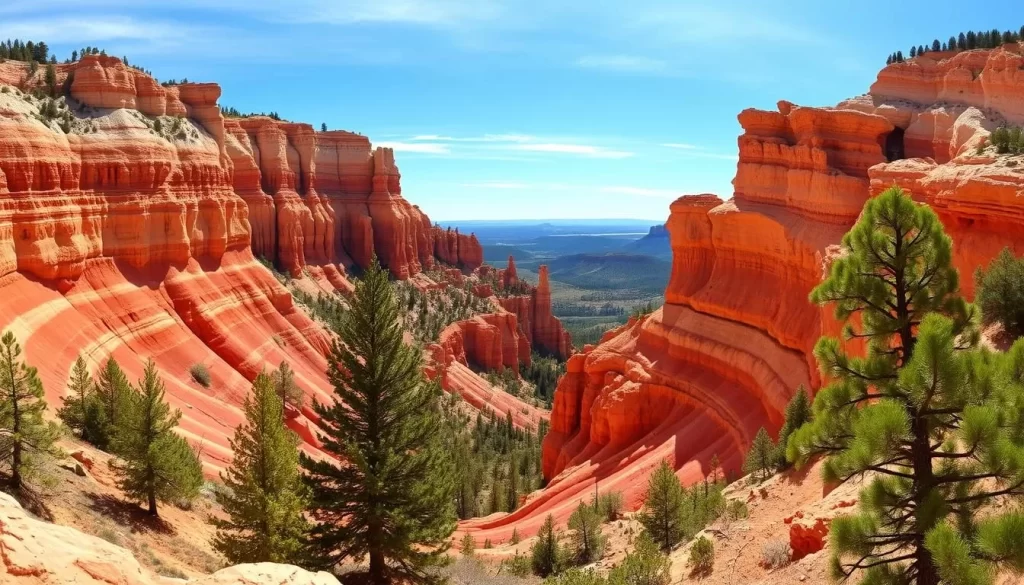
Best Hiking Trails at Cedar Breaks National Monument
For those looking to experience the great outdoors, Cedar Breaks National Monument features an array of hiking trails that showcase its unique ecosystems. The monument is home to several trails that cater to different skill levels, ensuring that every visitor can enjoy the natural beauty of the area.
Alpine Pond Trail
The Alpine Pond Trail is a 2-mile loop that takes you through meadows and forests, featuring a picturesque alpine pond. This family-friendly trail is perfect for nature observation, with interpretive signs along the way to help identify local flora and wildlife.
Spectra Point Trail
For a more adventurous hike, the Spectra Point Trail follows the rim of the amphitheater for about 2 miles, offering breathtaking views. Along this trail, you’ll encounter ancient bristlecone pines and unique geological features. Be sure to pace yourself and bring plenty of water due to the high elevation of 10,000 feet.
| Trail Name | Distance | Features |
|---|---|---|
| Alpine Pond Trail | 2 miles | Meadows, forests, alpine pond |
| Spectra Point Trail | 2 miles (one-way) | Ancient bristlecone pines, geological features, rim views |
Wildflower Viewing and Photography
The high-altitude meadows of Cedar Breaks National Monument burst into bloom during summer, creating a spectacular wildflower display. At 10,000 feet, the meadows are home to over 150 species of wildflowers, painting the landscape with vibrant colors.
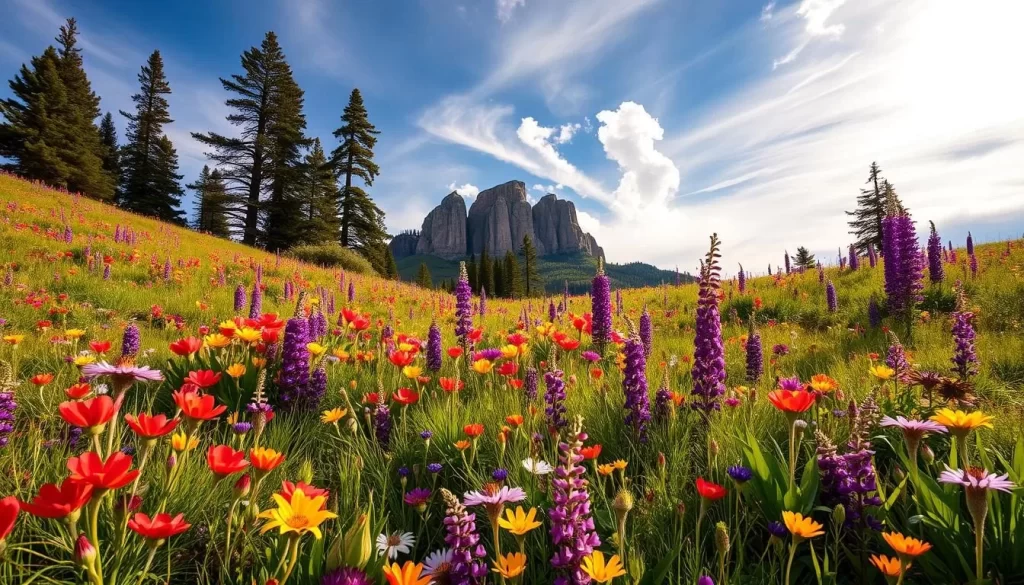
Annual Wildflower Festival
The Annual Wildflower Festival, usually held in July, is a highlight for visitors to Cedar Breaks. This event offers guided walks with rangers who help identify various wildflower species and explain their ecological importance, enhancing your understanding of the area‘s natural beauty.
Best Photo Spots
For photography enthusiasts, Cedar Breaks offers stunning opportunities, particularly in the southern Utah region. Capture the vibrant wildflowers against the backdrop of the red rock amphitheater, especially at spots like Sunset View and the Alpine Pond area, where morning light illuminates both flowers and formations.
Stargazing at Cedar Breaks
As night falls, Cedar Breaks National Monument transforms into a stargazer’s paradise. The monument is internationally recognized for its clear dark night skies, offering visitors the chance to see a vast array of stars and galaxies.
The area’s high elevation and remote location create ideal conditions for stargazing, allowing you to see thousands of stars, the Milky Way, and even distant galaxies with the naked eye.
Dark Sky Programs
During the summer months, you can participate in ranger-led Dark Sky Programs that include constellation tours and telescope viewing of planets, star clusters, and nebulae. These programs enhance your stargazing experience.
Star Parties and Night Photography
The popular Star Parties bring together astronomy enthusiasts and casual visitors alike, providing access to powerful telescopes and expert guidance. For night photography enthusiasts, Cedar Breaks National Monument offers unparalleled opportunities to capture stunning images of the night sky above the silhouetted amphitheater.
- Experience some of the darkest night skies in southern Utah at Cedar Breaks National Monument.
- Enjoy ranger-led programs and Star Parties for an enhanced stargazing experience.
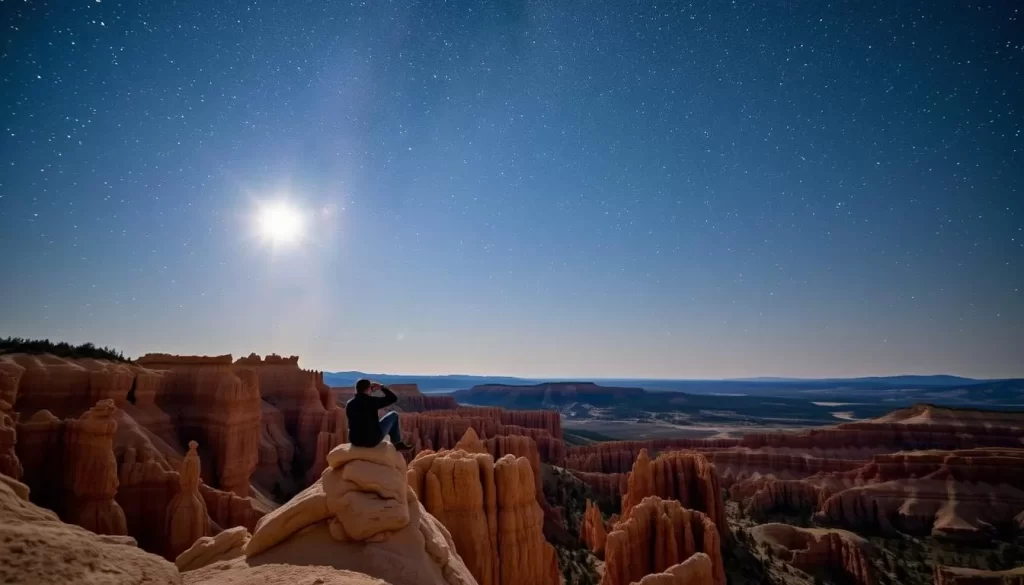
Seasonal Activities at Cedar Breaks
The changing seasons at Cedar Breaks bring a variety of adventures, from hiking and wildflower viewing to cross-country skiing and snowmobiling. You can enjoy Cedar Breaks year-round, with each season offering unique experiences and adventures in this alpine environment.
Summer Adventures
During summer months, you’ll find perfect weather for hiking, photography, and wildflower viewing. Summer temperatures typically range from 60-70°F during the day, providing a refreshing escape from the heat of lower-elevation parks. You can also attend ranger-led programs that explain the natural and cultural history of the area.
Winter Recreation
In winter, Cedar Breaks transforms into a snowy wonderland. Cross-country skiing and snowmobiling are popular activities, with access from nearby Brian Head Resort. The Winter Warming Yurt at Cedar Breaks serves as a winter ranger station and education center, welcoming visitors to warm up with hot cocoa after their snow adventures.
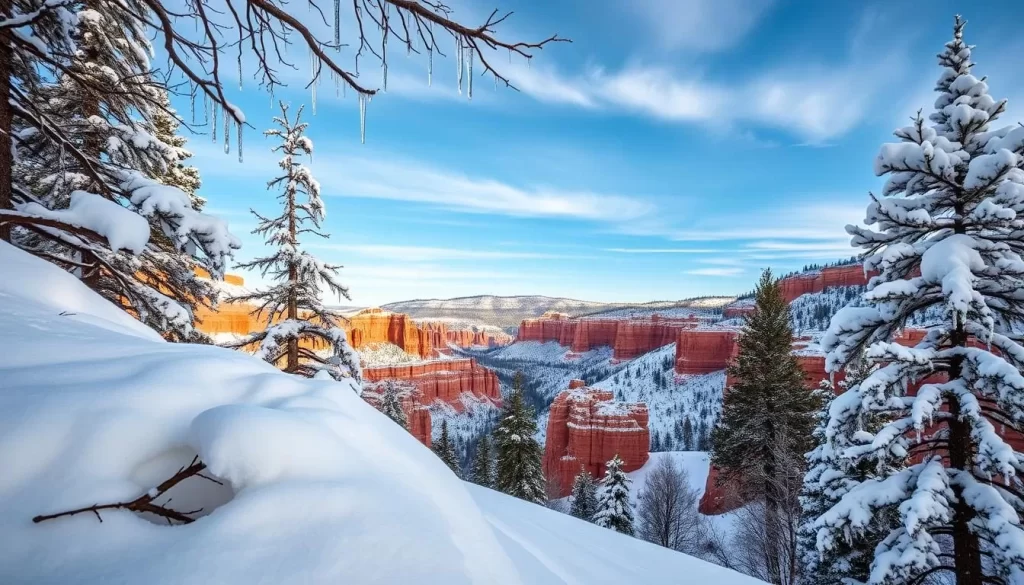
Nearby Attractions and Day Trips
Visitors to Cedar Breaks can enhance their experience by exploring nearby attractions. The area is rich in natural beauty and offers a variety of activities for all interests.
Brian Head Resort
Brian Head Resort is just four miles away from Cedar Breaks National Monument. It offers year-round mountain activities, including Utah’s highest-elevation skiing in winter and thrilling mountain biking trails in summer. The resort boasts a base elevation of 9,600 feet, providing spectacular views of the surrounding mountain landscape and distant red rock formations.
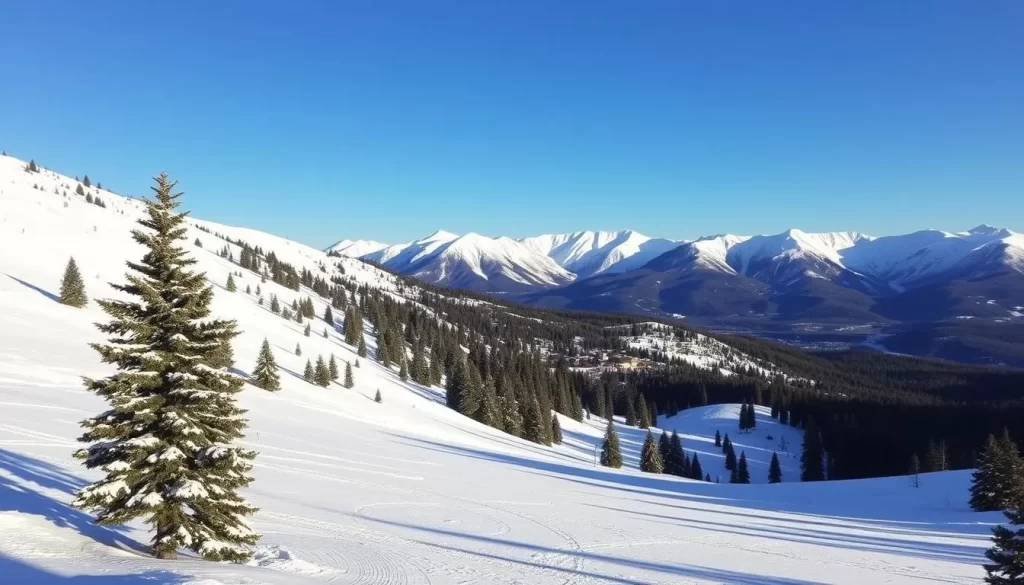
Exploring Dixie National Forest
The vast Dixie National Forest surrounds Cedar Breaks, stretching 170 miles across southern Utah. It offers additional hiking trails, fishing spots, and scenic drives through aspen and pine forests. Visitors can also explore nearby Zion National Park and Bryce Canyon National Park, showcasing different but equally impressive red rock formations and canyon systems.
Planning Your Visit to Cedar Breaks National Monument
To experience the natural beauty of Cedar Breaks National Monument, careful planning is essential. The monument’s high elevation at 10,000 feet means limited seasonal access and specific considerations.
Best Time to Visit
The best time to visit Cedar Breaks National Monument is from late May through mid-October when the main road, Highway 148, is open. Summer offers wildflowers and mild temperatures, while early fall provides beautiful foliage colors and fewer crowds.
Entrance Fees and Visitor Center
The entrance fee for Cedar Breaks is $10 per adult, with children under 16 being free. The pass is valid for 7 days, and America the Beautiful passes are also accepted. The visitor center, open from mid-June to mid-September, is a great resource to learn about the monument’s fragile environment.
Accommodation Options
You can stay at nearby Brian Head Resort, just 4 miles away, or camp at the monument’s Point Supreme Campground, which is open seasonally. Alternatively, lodging is available in Cedar City, 23 miles west, which also serves as a gateway to Zion National Park.
Conclusion
Cedar Breaks National Monument offers an unforgettable experience amidst its natural beauty. Your journey to this remarkable site provides an opportunity to witness one of southern Utah’s most spectacular natural wonders.
The monument’s unique amphitheater, surrounded by ancient bristlecone pines and vibrant wildflower meadows, offers breathtaking vistas under the star-filled skies. The proximity of Cedar Breaks to Cedar City makes it an ideal addition to your Utah travel itinerary.
Cedar City, known as “Festival City USA,” serves as a comfortable base with its dining, lodging, and cultural attractions, including the renowned Utah Shakespeare Festival. Whether you visit for a few hours or several days, Cedar Breaks National Monument will leave you with lasting memories.
It’s a place where you can appreciate the unique geological and ecological treasures of southern Utah, making it a must-visit destination for any traveler.
The above is subject to change.
Check back often to TRAVEL.COM for the latest travel tips and deals.
